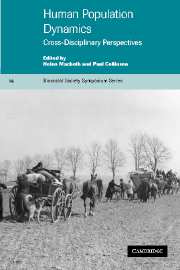Book contents
- Frontmatter
- Contents
- List of contributors
- Foreword by G.A. Harrison
- Preface
- 1 Introduction: the framework of studying human population dynamics
- 2 Demographic perspectives on human population dynamics
- 3 The growing concentration of world population from 1950 to 2050
- 4 Population, community and society in peasant societies
- 5 From genetic variation to population dynamics: insights into the biological understanding of humans
- 6 Social institutions and demographic regimes in non-industrial societies: a comparative approach
- 7 The dynamics of child survival
- 8 Genetic structure of south Indian caste populations: a confluence of biology and culture
- 9 Fertility, mortality and migration transitions in association with socioeconomic modernisation among highland minority populations in Southeast Asia
- 10 Ecology, homeostasis and survival in human population dynamics
- Glossary
- Index
- References
9 - Fertility, mortality and migration transitions in association with socioeconomic modernisation among highland minority populations in Southeast Asia
Published online by Cambridge University Press: 11 August 2009
- Frontmatter
- Contents
- List of contributors
- Foreword by G.A. Harrison
- Preface
- 1 Introduction: the framework of studying human population dynamics
- 2 Demographic perspectives on human population dynamics
- 3 The growing concentration of world population from 1950 to 2050
- 4 Population, community and society in peasant societies
- 5 From genetic variation to population dynamics: insights into the biological understanding of humans
- 6 Social institutions and demographic regimes in non-industrial societies: a comparative approach
- 7 The dynamics of child survival
- 8 Genetic structure of south Indian caste populations: a confluence of biology and culture
- 9 Fertility, mortality and migration transitions in association with socioeconomic modernisation among highland minority populations in Southeast Asia
- 10 Ecology, homeostasis and survival in human population dynamics
- Glossary
- Index
- References
Summary
Introduction
This chapter compares causes and consequences of population growth in the Lua' and the Hmong highland minority groups in Southeast Asia. The study illustrates roles of cultural patterns in, and impacts of, modernisation on population dynamics. It exemplifies many of the processes introduced in earlier chapters in relation to demography, change in social and health conditions, and population genetics. It relates changes in mortality, fertility and migration, and in geographic and social boundaries, to socioeconomic modernisation, including public health programmes, education, development and the market economy. This condensation of more detailed papers by Kunstadter and colleagues (see References section) suggests the value of holistic and longitudinal approaches.
Data were collected over four decades by conventional anthropological participant observation, health examinations, unstructured and structured interviews, surveys and questionnaires, some modelled on those developed for international comparative studies, such as the Demographic and Health Survey, with appropriate modifications based on discussions with members of the populations. Native speakers conducted most surveys.
Determinants of primary population variables
In Lua' and Hmong populations almost all fertility is confined to marriage. Thus age at marriage, proportion who marry, and divorce rates are important determinants of fertility, as are use of deliberate methods to delay, space or end pregnancies (Davis and Blake 1956).
Important biological determinants of fertility include age of reproductive maturity and senescence. These are influenced by nutritional status and infections, especially sexually transmitted diseases. Breastfeeding suppresses ovulation and protects infants from infectious diseases.
- Type
- Chapter
- Information
- Human Population DynamicsCross-Disciplinary Perspectives, pp. 162 - 185Publisher: Cambridge University PressPrint publication year: 2002



